Archive for February 26, 2010
Bonus Lost thought
February 26, 2010SPOILERS SPOILERS SPOILERS SPOILERS SPOILERS SPOILERS SPOILERS
Everyone’s wondering who Jacob wanted Hurley and Jack to summon with the lighthouse. Who’s #108? The name, according to Lostpedia, is Wallace–a name we’ve never seen before. Lots of people are guessing Desmond, but my guess is Walt. Mostly I just think that would be awesome. It’s also one of very few ways left for them to justify how important Walt was in the first two seasons. And on a purely logistical level, Walt’s been raised by four different people, so it should be easy enough for him to have a surname we haven’t heard yet.
But most importantly, it would also be the ultimate callback to that momentous, the-key-to-everything backgammon conversation Locke had with Walt in Season One: “Two players. Two sides. One is light. One is dark.” A final confrontation between Fake Locke and heretofore inexplicably psychically enhanced Walt would bring everything full circle.
Comics Time: Naoki Urasawa’s Monster Vols. 1-3
February 26, 2010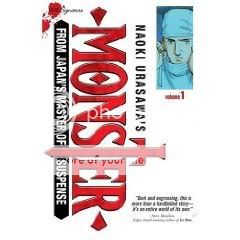
Naoki Urasawa’s Monster Vols. 1-3
Naoki Urasawa, writer/artist
Viz, 2006
208-224 pages each
$9.99 each
[First, a programming note. Because I read so many comics and write so many reviews, I end up reading and reviewing mostly self-contained works rather than long runs. The problem is I’ve been at this for long enough that a majority of the books on my “unread” shelves (plural) are part of big ol’ multi-volume series. Which is exciting! I love plunging into a world for as long as it’ll have me, that’s one of the great pleasures art can provide. But it presents a conundrum for a critic who posts three reviews a week, because on the one hand I’m accustomed to reviewing a complete work, so a big part of me would prefer to complete a series before reviewing it. Moreover, I don’t wanna bury the site in piecemeal reviews of a couple-three volumes at a time, just so no one, me or you, gets bored. On the other hand, I really like holding myself to this schedule, it’s fun and it’s been good for me as a writer and just as a reader too. And there’s probably something to be said for posting more than one review for a given series, tackling earlier and later material from it separately, seeing how both the material and my take on it change over the duration of its run. So for now that’s the direction I’m headed with this particular series, though in the future I may go ahead and stop posting reviews until I get a whole run read. Who knows? Life is a mystery. And so is…]
Naoki Urasawa’s Monster, the series that as best I can tell broke him in America, is a strange beast. You’ve got four distinct, and perhaps competitive, forces at play in these early volumes. Number one is the elevator-pitch concept: Brilliant doctor risks his career to save the life of an orphan, only for the orphan to grow up into a serial killer. Number two is the way that high concept broadens and complicates into a globetrotting (well, Germany-trotting, so far) political-thriller pageturner/potboiler. Number three is the frothy pulpy soapy melodrama of it all, with characters yelling about the sanctity of human life and children in peril and a villain who is repeatedly labeled “pure evil” Michael Meyers-style and geniuses in their fields who throw it all away for the sake of the job and on and on. Number four, maybe the most interesting force at work, is this undercurrent of meaty and specific social issues that weave in and out of the genre business: German reunification and its discontents, being an Asian immigrant in Europe, medical ethics and hospital politics, child abuse (depicted in a shockingly frank fashion at times).
And as I’ve pointed out in the past, Urasawa’s art plays it all totally straight. It’s just pure craft, existing for the sole purpose of getting the story across and over. The people look cartoony, yes–they remind me of Disney house-style people, not in terms of their specific look but in the way they function as vehicles for immediately intelligible ideas and emotions. The clarity they comprise is so…overpowering, I guess is the word, so able to lodge in your brain, that this morning as I was thinking over Footnotes in Gaza again, the people of Rafah appeared to me in Urasawa style, not Joe Sacco style. My point, though, is that apart from their cartooniness and penchant for yelling, which could point toward the pulp melodrama as the dominant thread for the series, the character designs and the art in general really don’t tip their hand as to what you “should” be making of all this. Is it “just” addictive thriller storytelling? Are we meant to take the various waxings philosophical seriously, is the thriller stuff and the in-your-face villainy and the way we’ve met four or five people so good at their jobs that it’s broken up their marriages intended as a palatable container for it? Or is it vice versa? This is what American serialized genre-entertainment fans might call the Lost question (a comparison I’ve made with Urasawa’s stuff before). Frankly, I think that in Monster‘s case the pulpy stuff wins the day hands down–the issue-y stuff is reeeeeeeally broad. But I suppose the point here, in the end, is that if you can read the first volume and not want to read the next 17, you are made of sterner stuff than I.
Carnival of souls
February 25, 2010* Happy 10th Blogiversary to NeilAlien, Skyfather of the Comics Blogosphere. (Via Tom Spurgeon.) Spurge’s list of 21 cool things about Doctor Strange is a pretty great birthday present.
* Today at Robot 6 I talked a bit about Geoff Johns’ post-promotion charm offensive.
* Plenty of fun Lost links today (and don’t worry, I’m gonna be keeping the Carnival spoiler-free unless otherwise noted). First up, Todd VanDerWerff’s weekly follow-up post, which includes more interesting discussion of Jack–who’s one of my favorite characters on the show, let me just come right out and say it–and in which VanDerWerff shares my enthusiasm regarding a potential identity for a potential someone.
* Next, Noel Murray’s review/recap for the Onion AV Club struck me as particularly sharp and observant this week, regarding everything from a weakness of some of the dialogue in this episode to the throwback elements it included to a way in which the final seasons will increase our investment in the first to parallels between this episode and the corresponding installment of Season One to making fun of Doc Jensen.
* Keep comin’ back to the comment thread on my Lost post for the week if you please–insights and compelling debates abound.
* Finally, good golly, look at this “visual timeline” Olivier Lacan is building for Lost! Right now it’s very much a work in progress–there are more gaps than there is timeline at this point. And it’s not very well written. But it’s a great idea, executed with gorgeous screencaps, and it’s as good a reminder of the show’s sweep, scope, and mystery as anything I’ve seen. Soak it in. (Via Whitney Matheson.
* Super Mario Galaxy 2!!!!!
As I watched that trailer I literally became frightened of how much time I will be spending playing this game. As Rob Bricken at Topless Robot points out, it’s very very similar to the first game, but man, if it ain’t broke.
* Gene Simmons is one of the worst people in the entire history of recorded music, without exaggeration. Just a loathsome creep in almost every conceivable way. Turns out the apple doesn’t fall far from the tree, as his son Nick Simmons flagrantly plagiarized Tite Kubo’s Bleach for his comic Incarnate–a plan that would seem to require no one reading his comic for it to succeed–and then issued denials that manage to be simultaneously insulting to manga, threatening to his detractors, and transparently bullshit to all. My favorite report on all this today is Rob Bricken’s at Topless Robot, which does not hold back.
* Want. Tom Neely, ladies and germs.
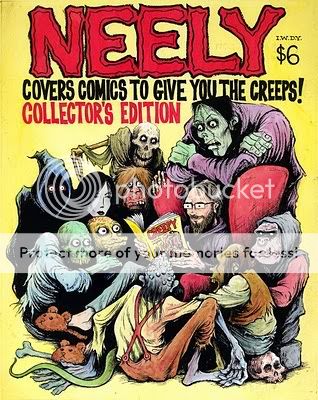
* More Destructor art from the LAW! King Suckerman, Rickey Purdin, and this killer piece by Zach Oat.
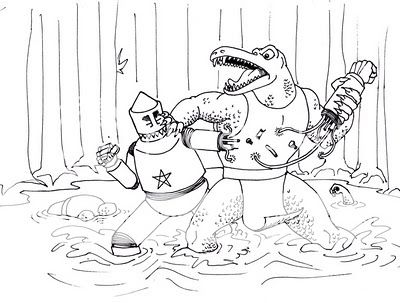
* Oh hey, Fuck Yeah, T-Shirts is back.
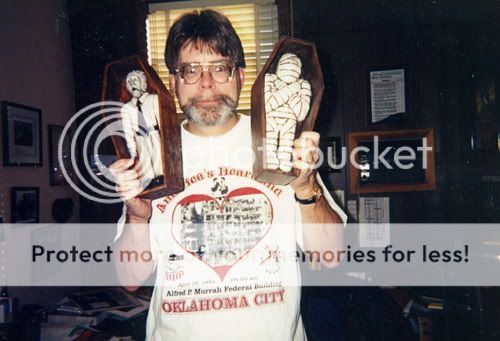
Comics Time: Batman & Robin #9
February 24, 2010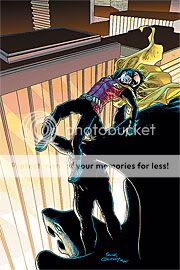
Batman & Robin #9
Grant Morrison, writer
Cameron Stewart, artist
DC, February 2010
24 story pages
$2.99
I’ve been a bit of a broken record on this score lately, but here is another comic I want to physically force the writers and artists of other action-dependent superhero comics to read, eyeballs propped open A Clockwork Orange-style. Consider if you will the care and attention paid to the page on which Batman and Batwoman pound the stuffing out of Zombie Batman. (Okay, first consider that this comic contains a page on which Batman and Batwoman pound the stuffing out of Zombie Batman. Then move on.) Look at the way the fight choreography flows from one panel to the next. It’s not just a series of random cutaways: The pivot you see Batwoman executing in the background as Batman punches Zombie Batman in the jaw of one panel leads into the kick you see her deliver in the foreground as Batman cocks his other fist in the next panel, which leads into the left hook you see him land in the panel after that. Or return to earlier in the issue, where a still-wounded Robin and out-of-his-league Alfred battle the Zombie Batman using the objects (a wireless computer mouse, a wheelchair) and environments (an elevator) available to them, each beat portrayed with crystal-clear visual logic and visceral impact. I could seriously reread that sequence where Zombie Batman gets choked with his own cape as Alfred snags it into the elevator and hits the Up button, until Zombie Batman cuts himself loose with a batarang, over and over again. God how it cleanses the palate of the umpteenth two-page melee spread.
What’s still more delightful about this issue is that Stewart brings these same chops to pretty much everything he draws. Look at the knowing Mona Lisa smile on Batwoman’s face as she tells the romantically interested Dick Grayson not to get his hopes up, sharing an inside joke with those of us beyond the fourth wall. Look at how Batwoman’s father looks like he wandered in from another comic as he pops up in street clothes among a gaggle of costumed crimefighters, emphasizing what a gonzo concept it is to have your dad be your sidekick more clearly than anything I’ve seen in Batwoman’s solo adventures to date. Look at Zombie Batman himself, as much a gift to the toy folks as the Batman of Zur-En-Arrh was and the Batmen of the Timestream are about to be. And I could definitely stand to see the double-punch panel become as much of a trademark element of Batman and friends as using “Bat” as a prefix.
Oh yeah Grant Morrison’s involved too. What I liked best about his work here is usually what I like least about Batman comics: His army of increasingly interchangeable crimefighting tagalongs. The real Batman isn’t even in the comic anymore, of course, so this book features no fewer than nine such characters, if you count Zombie Batman; four of them are direct riffs on Batman himself. But from Papa Batwoman’s military jargon (via a pretty effortless and kind of funny Greg Rucka impression on Morrison’s part) to Knight and Squire’s jocular “keep calm and carry on” comportment to Dick and Batwoman’s born-of-necessity ability to think and act on their feet and in tandem, each one seems not just like a different person, but a whole person, not just a one-dimensional reflection of some aspect of the real Batman that the writer wants to have walk around on its own for a while as these things frequently are.
I hate when people set themselves up against some largely imagined consensus, but I am going to go ahead and say that I do miss the sense of mounting mystery and menace of the Morrison material that culminated R.I.P, which I’m guessing is a minority position among the sorts of folks whose blogs you’re likely to read if you read this one. But Batman & Robin, and this issue perhaps more than all the others so far save #3, is a fine, fun superhero comic, set in the milieu of the only superhero I really love in and of himself. Who couldn’t use one of these now and then?
Carnival of souls
February 24, 2010* Amy Sedaris and George Takei are among the voice actors in the amazing pilot for Neon Knome, Paper Rad/Cold Heat impresario Ben Jones’s Adult Swim series-in-waiting. But it will never end up on the air for you to abuse Ambien to unless you vote for it in this contest. Team Comics already pissed away a decade’s worth of increased clout by failing to get Michael Kupperman’s Snake ‘n’ Bacon over; let’s not let this happen again.
* More Destructor fan art over at We Are The LAW, this time from the great Chris Ward. Look for a tease of a future Destructor storyline in the comments!
* Looks like Zak Smith/Sabbath’s Playing D&D with Porn Stars is going to be regular reading for me: Dig this entry on a creation of his called the Vomiter, which is basically a postapocalypitcally infected human who pukes a creature selected from the monster section of the guidebook with a roll of the dice out of an internal dimensional vortex. Damn.
* Todd VanDerWerff may well be the only Lost critic worth reading. It’s delightful watching him think about Jack, even as someone who (unlike VanDerWerff and about 90% of the show’s audience) has never not liked the character.
* Speaking of Lost, things are cooking with gas in the comment thread for this week’s post on the show, so be sure to chime in if you’re interested.
* Speaking of lotsa interesting comment-thread fodder, many smart people have chimed in about George R.R. Martin’s Song of Ice and Fire/Game of Thrones books, in such a way as to intrigue me, even if I can immediately grok Tom Spurgeon’s reservations about them.
* ADDTF fave Ross Campbell is doing a new superhero book from SLG called Shadoweyes, but because it’s a Ross Campbell comic, it starts with two gothy girls lying around on a bed and eating vegan food, so that’s good news. My chums at Robot 6 have an interview about it and a preview of it.
* Gary Groth’s grudging admission that TCJ.com is the pits rapidly became as irritating as his initial “We’re now gracing your shitty comics Internet with our presence–you’re welcome, America” post, so it’s nice to see Chris Allen smacking the new post around a bit. I’ve said it before and it looks like I’ll be saying it again and again: You can’t win just by showing up anymore.
Lost thoughts
February 23, 2010* Alright, another very good episode, intriguing in both timelines, lots of juicy mythology, fun performances, action, hieroglyphics, dead people, the whole nine. So far the only false note for me this season has been the Great Kate Escape episode. Three out of four ain’t bad.
* During one of the initial segments of Jack’s flashsideways, he seemed as taken aback by his appendectomy scar as he seemed to be on the plane by the cut on his neck and just the general way he looked in the mirror. They made a nice big deal of this this time, complete with a call to Mom asking when he had the operation, so methinks there’s something fishy going on with this whole alternate timeline, that it’s not as simple as “what would have happened if the Island had been nuked in the ’70s.”
* And I’m glad of that, because it’s only now occurring to me why some part of me never quite believed that was where they were headed in the first place: I never consciously made this connection, but the idea that we’re seeing what life would be like if something bad had never happened to them and they lived happy lives instead is straight-up The Last Temptation of Christ and/or “For the Man Who Has Everything.” Obviously the Lost writers aren’t above riffing on or referencing other big genre works–The Dark Tower, The Stand, Watchmen, we can all rattle off another half-dozen major touchstones easy. But never do they simply lift storylines wholesale. This ain’t Heroes, and Jeph Loeb hasn’t worked on the show since Season One. So while I had speculated that maybe this would all lead to Jack or Sawyer or whoever seeing how much better their life would be without the Island but somehow sacrificing it all for the greater good, I don’t think that’s where we’re headed anymore, at least not in the “Christ still chooses to die on the cross/Superman decides to rip off the psychic plant and kick Mongul’s ass” way I was kicking around.
* So, in each flashsideways, our protagonist character will bump into an Other? Kate and Claire met Ethan, Locke met Ben, and Jack met Dogen. Once is happenstance, twice is coincidence, three times is a pattern. Or to use Ian Fleming’s formulation, three times is enemy action. Dun dun DUNNNNNN! Anyway, I like this because it means we’ll probably see big Tom again. Speaking of which, did you notice the last name “Friendly” on Jacob’s lighthouse wheel? He really was “Mr. Friendly”! Oh, Lindelof & Cuse, you kidders.
* We’ve learned, if it wasn’t clear already, that the Man in Black is an out-and-out liar. Obviously he was pretending to be Jack’s dad. Obviously as such he only pretended to be speaking on behalf of Jacob. Claire tells us “her dad” told her that the Others stole her baby, which isn’t true. Thus one can assume he was seriously fudging the truth for Sawyer too. My brother Ryan pointed out that a cave hollowed out of a sheer cliff wall over the ocean seemed like an odd place for Jacob to hang out, making him skeptical that that was ever Jacob’s place to begin with. The moment I saw those 360 names written out in an orderly fashion next to each degree on the wheel, I thought, “Well, I guess there was probably no need for Jacob to have scrawled them all over the roof of a cave someplace else on the Island.” Particularly if the wheel is a magic portal into all their lives, right?
* Who’s the momma? Juliet?
* I loved all the callbacks to Season One. Shannon’s asthma inhaler, the caves, going on a jungle quest, Jack recalling his vision of his dad…Thinking back, it really did seem like that was just a vision, for a long long time after that episode aired. Maybe an Island-inspired vision, but a vision nonetheless. I wonder how long it took for the writers to decide “You know what? That really was his dad!” Then again, the body was missing from the coffin all along, so who knows.
* I would say that Hurley’s speculation that the skeletons in the cave are two of their own, as a result of time travel, shoots down the possibility that that’s actually the case. But remember back in the day when they got “Moonlight Serenade” by Glenn Miller to play on the radio and Hurley said it could be coming from anywhere “or any time?” He added a quick “just kidding,” and at the time I thought that was the creators’ signal to us that we didn’t need to bother with spacetime continuum theorizing. Whoops!
* Jacob’s a manipulator too. Important to remember. What I really want to know is whether the Others’ rather barbaric conduct over the seasons are a result of a more-or-less faithful interpretation of his orders, or if things are way off base due to either a communication breakdown or deliberate malfeasance by Ben or Richard or Widmore or Dogen or whoever the relevant person is.
* With Jacob looking on approvingly, newly minted leadership-position Hurley opts to be cryptic and not answer Dogen’s question. So THAT’S how they learn it!
* The animal-corpse baby in Claire’s basinet was the most disturbing thing the show has served up in a long time. Like, it made me really uncomfortable for the brief few seconds we saw it. That is Texas Chain Saw Massacre shit right there. I’ve said this before, but as we’ve learned more about the Others, the Dharma Initiative, the Monster, and so on, a lot of the sense of fear and horror that these things presented in the earlier seasons, when the show was often one of the scariest on television, gradually dissipated. It’s nice to see them try to inject it back in.
* And hey, an axe murder! Alright.
* I don’t know if this was something they thought of, but of all the characters they could have left to the tender mercies of crazy Claire and evil Locke, Jin was an excellent choice because he spent years trying to stay one step ahead of the wishes of a vicious gangster. I believe that he’s someone capable of thinking on his feet and staying alive around the homicidally violent, longer probably than any other character except maybe inveterate conmen like Sawyer or Ben.
* Here’s the thing, though: Fake Locke knows that Jin knows that they’re both lying about who has Claire’s baby. Sawyer, who’s with Fake Locke, will know it too. How’s all that gonna work?
* Back to the Lighthouse for a second: I thought this was a fine scene, because it delivered something we haven’t seen…mmmmmmaybe since Locke refused to press the button at the end of Season Two? Which was someone getting so fed up with the way the Island’s phenomena have used and abused him that he snaps. There was an interesting new dynamic in play here as well: In the Hatch, Locke really had no evidence about whether what he was doing was extraordinary or bull, he just didn’t buy it anymore. Jack, on the other hand, just got a glimpse of his childhood house, and someplace in Japan, and maybe Oxford or something, in the mirrors of a magic lighthouse to which he’d been led by someone who got his directions from a dead man only he could see or talk to. Jack knows damn well that something really astonishing is happening on the Island, in reference to him specifically–and it’s precisely that knowledge that’s driving him crazy, not the lack of knowledge that so tormented Locke. Jack smashing the mirror (did he hear or fear or…?) was six seasons of not knowing what the hell is going on exploding into action. Good stuff. (I sort of wish the smashing hadn’t been spoiled by the stupid network’s next episode teaser last week, but oh well. It was at least nice of them to try to avoid making that mistake again this week.)
* I loved seeing all the hieroglyphics on the temple hallway wall, just ‘cuz you know they threw that in there so that the Lostpedia folks would translate it. And translate the Japanese dialogue, and freezeframe every glimpse of the wheel, and so on and so forth.
* Who’s coming to the Island? I’m pulling for Walt. I can barely fathom how satisfying that would be.
Carnival of souls
February 23, 2010* Want to reignite interest in your bloated, overlong, shit-the-bed-in-the-third-movie Pirates of the Caribbean trilogy in two easy steps? Cast Ian McShane as Blackbeard and break open the fuckin’ canned peaches.
* Though she is a supporter of motion-capture performances like that of Andy Serkis as Gollum in The Lord of the Rings, Kristin Thompson writes a compelling essay about why they nevertheless shouldn’t qualify for the traditional acting Oscar categories. This is a mitzvah, as the argument really should be hashed out by people with an appreciation both for the technology and the reasons why it’s different than traditional acting, and not as some Internet-style “LUDDITES VS. THE FUTURE” flamewar. One thing though: Zoe Saldana was getting Oscar buzz for her performances as Love Interest in Avatar? I thought that character and everything she brought to it was just as rote as everything else in the movie.
* I haven’t read George R.R. Martin’s A Song of Ice and Fire series, though it’s very very high up on my list of “next big prose series I’m reading.” (Right now in my head I’m going through a long digression about how there’s only so much time in the day and how much my Comics Time reading and reviewing prevents me from reading long serialized works of both comics and prose, and moreover how I’ve had the first two discs of Mad Men Season One in my backpack for like four months, and how I’m only up to World 5 of New Super Mario Bros. Wii, and god only knows how long it’s gonna take me to get through all of Naoki Urasawa’s Monster now that I have all 18 volumes finally, and hey what about the long-promised revision of my anti-Jaime Hernandez Love & Rockets thing that would require me to read all those digests, and for Chrissakes I’m not even up to First Bull Run in the John Keegan American Civil War book, and on and on and on. But you can take it as read.) But it seems to me that an HBO grown-up fantasy series could be to die for, and casting Sean Bean in the lead seems like a great way to start. The whole rest of the cast can be seen at that link, too. Maybe readers can chime in as to who’s good and who sucks in the comments.
* Marc-Oliver Frisch sings the praises of Soldier X. My great hope is that all this Internet attention will spur someone at Marvel into saying, “Ah, what the hell, let’s collect the damn thing.” Help us, David Gabriel–you’re our only hope! Anyway, here’s a nice bit from Marc-Oliver’s review:
This is the point where Soldier X reveals its kinship with Steve Gerber and Mary Skrenes’ Omega the Unknown, but also with Grant Morrison’s Final Crisis. Like those works, Soldier X treats superheroes as a metaphor for the literal limitlessness of the human imagination–easily the single most compelling aspect of the genre, as well as, unfortunately, the single most overlooked one.
* A shadowy cabal of my chums from one of my ex-employers has started up a sketch blog called We Are The LAW, where we’re taking turns drawing characters we like. We’ve actually kicked things off with two characters of our own devising: Justin Aclin’s Geist from Hero House, and mine own Destructor from my comics with Matt Wiegle. I want to emphasize that only a handful of us can actually, you know, draw, but hey, what the hell. Below is Geist by me, Destructor by Ben Morse, and Destructor and friends by T.J. Dietsch. Click the links for the full-sized versions.
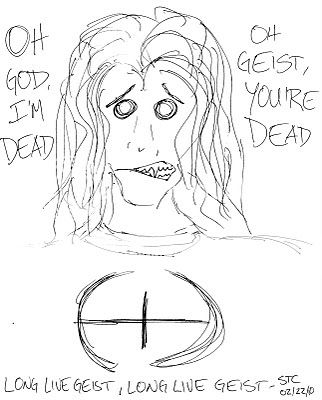
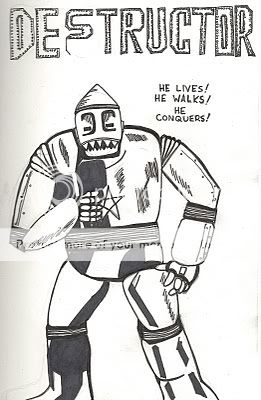
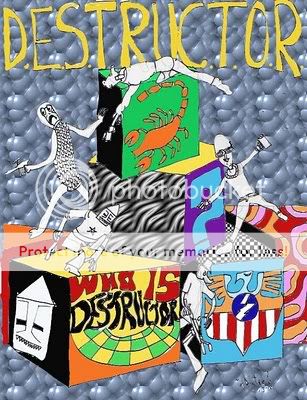
* Elsewhere, Rickey Purdin draws the Black Flame from B.P.R.D. The sequence where he walks into the Zinco boardroom in full Nazi supervillain regalia with his head on fire and announces “You’re all fired” is one of the all-time great comic book moments I’ve ever read. Full stop.
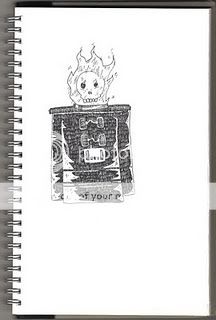
PS: I wonder if Zinco and Cinco have any connection?
* A good way to prep for tonight’s Lost is to read what Kiel Phegley’s mom Lynn thought of last week’s episode. Imagine a recap column written by Lapidus and you’re pretty much there.
The Side Effects of the Cocaine
February 22, 2010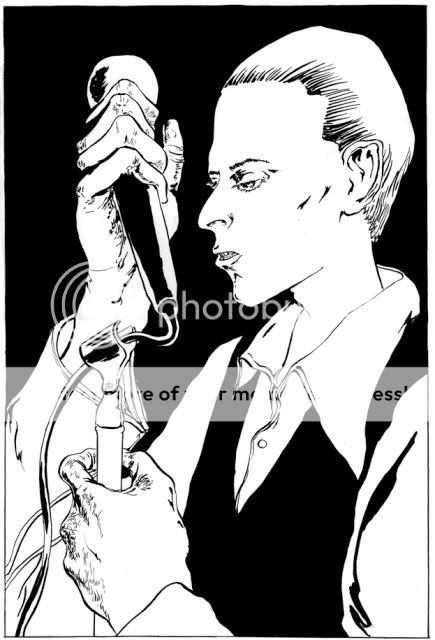
I wrote a comic called “The Side Effects of the Cocaine” about David Bowie’s very strange sojourn in Los Angeles between the release of Young Americans and Station to Station. Isaac Moylan was kind enough to draw it. You can read it at Isaac’s site. I hope you enjoy it!
Carnival of souls
February 22, 2010* Is Siege a bomb? I have no idea but maybe you’ve got an opinion.
* Also on Robot 6 today: The LA Times’ Graphic Novel Book Prize finalists are a strong group, and this is the first and probably last time I’ll ever think of Gareb Shamus and Robert Altman at the same time. This weekend I also revealed what I’ve been reading. Click that last link for an interesting take on Blackest Night and Siege from Tim O’Neil, too.
* Tom Spurgeon is to the new DC executive team what the Daily Kos is to the Obama Administration: Rhetoric is nice, but he demands action on a progressive agenda.
* Speaking of Spurge, just try to resist buying Dan Nadel’s Art in Time after reading this review.
* To Ceri B. and all RPG-interested readers: Zak Smith is a very very good artist and one of my fellow “Fifth Beatles” vis a vis the Partyka group. He’s also a fellow Son of Eli. He’s also writing a fascinating blog about being a D&D Dungeon Master, featuring posts like this killer piece on four different kinds of vampires and how to play with their varying rule sets. He’s also a porn star who’s playing D&D with Mandy Morbid, Satine Phoenix, Kimberly Kane, Sasha Grey, Justine Joli and so forth. Definitely check out his blog Playing D&D with Porn Stars. I’m looking forward to their upcoming video series I Hit It With My Axe, which will basically be them playing a campaign you can follow like a TV show. That’s a rad idea, porn stars or no.
Comics Time: Doomwar #1
February 22, 2010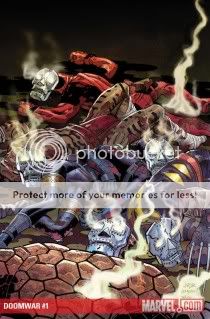
Doomwar #1
Jonathan Maberry, writer
Scot Eaton, artist
Marvel, February 2010
34 story pages
$3.99
This isn’t a review so much as a couple paragraphs about how rad I think Doctor Doom is:
Doctor Doom should be King Shit of Marvel’s Turd Mountain. Seriously, he should be the one bad guy that makes even all the other bad guys go, “Whoa.” He rules his own country, he rivals Doctor Strange on sorcery and Mister Fantastic on science (and ranks with both of ’em on the awesome-name score), he’s up there with Iron Man on the super-armor scale, he’s got a great look, and he’s like crazy arrogant and angry all the time. He’s the ur-villain. What I’ve liked about his recent cameos in books like Captain America: Reborn and Siege: The Cabal is that the other big-deal villains like the Red Skull and Norman Osborn seem to realize all this but still attempt to use Doom for their own ends, because his skills make him too useful and their own megalomania blinds them to the downside of crossing him. That’s about right.
However, it always feels to me like he’s overused in terms of his interactions with heroes. I don’t mind him constantly in sotto voce contact with the other big schemers, that seems like something Marvel’s megalomaniacal mastermind-type villains would always be doing. But when he jumps ugly with the good guys, that to me is the kind of thing you save for an every-few-years jolt, not a constant string of tussles. He’s just too formidable a threat to frequently use without devaluing the brand. Every appearance should be for the ages, and his every interaction with a hero or team should alter their status quo for the long term. (I actually think that’s true of every A-list villain, but I understand the difficulties involved; Doom seems like the kind of character you ought to try really hard to do right regardless.)
Is Doomwar the kind of Doom-based throwdown I’m looking for? It’s too soon to say. Doom himself is just a puppetmaster in this early installment, though his master plan as it’s been described to us by Black Panther siblings T’Challa and Shuri, whom he has dethroned, is suitably pseudoscientifically apocalyptic. Seizing 10,000 tons of Vibranium from Wakanda and using it to unlock god knows what mystical mumbo-jumbo is the kind of thing you’d figure Doom would spend his afternoons planning. Being an ice-cold murderer in support of it, shooting a civilian every few minutes until Storm, the current Queen of Wakanda, acquiesces to his demands–yeah, that’s also something Doom would do in my book. What does he care? He’s a tyrant, let him be tyrannical. I understand that that’s the sort of thing lots of people will just read as “icky,” but villains have been killing people in genre material young people have read for decade upon decade. Saruman’s goons wased a bunch of hobbits for pete’s sake. I’ll live.
What’s interesting about Doomwar is that I didn’t expect it to be so…Brubakerian, I guess is the word for it. It’s “superheroes as black ops” in the Mighty Marvel Manner. Scot Eaton is drawing in that scratchy Marvel house style of the past several years; it’s much more of a piece with Steve Epting and Mike Perkins and Butch Guice than with the jazzy John Romita Jr. covers the book sports, although he shares with JRJR a real knack for drawing bruisers. Colossus, T’Challa, and Doom all look like dudes you wouldn’t want to mess with at all. Meanwhile, the concept could have come straight from one of Ed Brubaker’s Captain America storylines, too, and insofar as it’s about a sinister group that uses an appeal to patriotism to wrest control of a democracy over to a sinister outside force–the plot of Brubaker’s “The Man Who Bought America” arc, with Wakanda instead of America and Doom instead of the Red Skull–that’s basically what it did. It even shares with Brubaker Cap a knack for resonating with current events without referencing them outright: I can’t be the only person who thought of Uganda’s anti-homosexuality legislation when reading the coup leader’s diatribe against mutants and witchcraft and suchlike. In turn, the Black Panthers are presented less as superheroes than as exiled leaders plotting the violent overthrow of the regime that violently overthrew them first. Cyclops and Emma Frost quietly funneling various X-Men to them in hopes of freeing Storm reads like a mutantified version of Charlie Wilson’s War.
I suppose this could all come across as rather dreary and by-the-numbers. And it might be, if not for a few factors. One is the presence of Doom, so far latent rather than actualized, and my lingering hope that he’ll do something totally awesome. Two is Eaton’s literally muscular art–I find I just like looking at it a lot. Three, and most promisingly, is an out-of-left-field ending that short-circuited my every expectation of what the primary business of this series was going to be for the rest of its issues. The way it goes down actually gives me more faith in the future fortunes of the aforementioned Factors One and Two, in fact. Fingers crossed.
Carnival of souls
February 20, 2010* I thought Tom Spurgeon’s ten thoughts on the DC management announcement were pretty solid.
* Recently on Robot 6: Cameron Stewart makes a Batman & Robin-related funny and John Porcellino makes a Batman & Robin-related drawing.
* Ben Morse has a round-up of recent Winter Games What The–?! silliness at Marvel.com. I really do love his profile of Team Transylvania.
* Renee fucking French, man.

* Frank Santoro is my favorite webcartoonist.
* If you’ve ever looked up at a big building and are a superhero fan you’ve probably thought about what a battle atop it would really look like to onlookers, which is why this Robt Seda-Schreiber cover version of John Romita Sr.’s cover for Amazing Spider-Man knocked my socks off. Making the action smaller makes the action bigger, you know? Click the link for the full-size piece.

* Real-Life Horror: John Yoo, who still has his law license and teaches at Berkeley, gave the legal thumbs-up to literally massacring civilians.
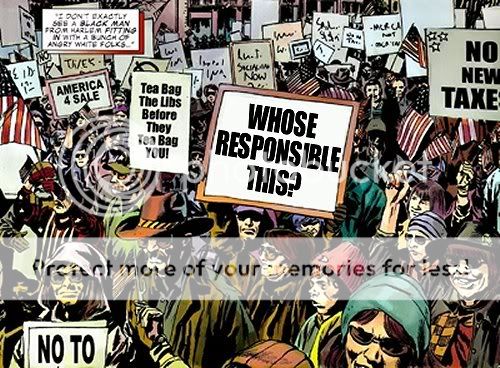
Comics Time: Footnotes in Gaza
February 19, 2010
Footnotes in Gaza
Joe Sacco, writer/artist
Metropolitan, December 2009
416 pages
$29.95, hardcover
Journalist Joe Sacco’s latest book is about two massacres of Palestinian civilians by Israeli soldiers in two Gaza Strip camps/towns during the Suez Crisis in 1956. I think there are several things you can point to in it and say “Joe Sacco does that very well.”
The first is what you might refer to optimistically as scale or pessimistically as sprawl. There’s a memorable three-page sequence in the early going tht compares what the Palestinian refugee camps looked like in the mid-’50s, the time of the events the book spends most of its time chronicling, to what they looked like in the mid-’00s, which was when Sacco did the chronicling. On the first splash page, rows of little brick houses with sloping roofs and walled-in yard-like compounds trail off into the distance; a little street crosses the page in the foreground while the rows stop short of the horizon, which is buffered by a strip of wildnerness and then another, barely visible town just at the limit of sight. On the second page, giant apartment buildings jut upward against tiny shacks whose metal roofs are pinned down by bricks, tires, and debris; the roofs and clotheslines and water towers and telephone wires begin right at the bottom of the two-page spread and keep going until the taller buildings literally blot out the vast majority of the horizon, and even chunks of the sky. The message seems clear: Things may have been pretty bad for the impoverished, angry people of Gaza back then; everything is worse now. This is driven home later in the book by a second spread that mimics the set-up of the one that established the look of the camps today: This one show a barbed-wire fence and the ruins of bulldozed homes as far as the eye can see. Sacco is fond of that temporal-juxtaposition device, never more brutally used than when we see a contemporary row of cars parked against a wall on the right-hand side of a spread where dozens of dead bodies had been shown to us against that same wall some fifty years before on the left-hand side. Sometimes Sacco uses his skill with scale not for a landscape or panorama, but for single structures: The IDF towers that oversee the town of Rafah or a nearby checkpoint on the road to Gaza City rear up to the sky like menacing robots, while bulldozed multi-story building where many people once lived dwarfs us with the absence of it that we project against the sky. Other times it’s explosions and chaos that overwhelm us, swirls of stippled smoke and fire obliterating buildings and bodies alike.
The second thing Sacco does well is visual repetition. You see this in that initial page of the mid-century refugee camp and its little block houses, of course. But later, you see it with bodies. Men forced to run pell-mell through the streets of their camp by angry soldiers firing in the air, and sometimes not in the air at all. Often they are all made to strike the same pose, arms in the air to show they are unarmed; the unnatural positioning leads to a criss-cross effect as the men scramble around and past and behind and in front of one another. Sacco will shift to a bird’s eye view here, make skillful use of alternating gray and white clothing there, freeze the men with their backs to us like they’ve been paused in the middle of a Michael Jackson video dance routine here, throw them into a morass of beatings by the Israeli soldiers like a nightmare version of that third, battle-heavy Where’s Waldo? book there. Repetition leads to perhaps the book’s single most striking visual: The men of the town of Rafah, rounded up en masse in a schoolyard, forced to sit on the ground with their hands on their heads for hours at a time. Sacco shows this vista from slightly above and in front, from a three-quarter angle, from behind; the men become a featureless mass of little ovals of fear and discomfort, bleeding and pissing on one another, slightly cracked eggs in a massive carton.
The third thing Sacco does well is conveying a sense of action, or intense activity if you distrust that word’s genre connotations. Sacco’s careening caption boxes alone can get across the sweep of a magnificent view, the interruptions of constant cellphone calls, the chaos of constant violence, the chatter of a party, the march of history, the swell of a crowd, and the dance moves of beautiful women all by themselves–and in the book’s first seven pages, they do all that and more. Elsewhere he uses perspective tricks, like a swoop of flame that makes it look like a burning soldier has literally been propelled toward us. In the chaos of a sudden attack by an Israeli patrol he cross-cuts two different sentences like a giant X across an almost collage-effect collection of panels showing him and his companions as they flee in all directions; you have to read one of them backwards, manga-style. And it’s all but impossible to forget the montage based on the two stick-swinging soldiers seared into the memory of every man in the town as they tee off on hundreds of terrified captives being herded through a narrow gate, or the jump-cut chaos of a black-bordered POV sequence that makes as bold a use of the cut-to-black as anything since a certain HBO TV show.
The fourth thing Sacco does well is portraiture. This book is just as much a Beard Parade (and Mustache Parade, and Grumpy Little Kid Parade, and Wrinkled Old Lady Parade) as R. Crumb’s Book of Genesis Illustrated, and there’s just as much care and attention put into differentiating each from the other. (The exception are the Israeli soldiers in the flashback sequences; they have a uniform build, the shadow of their pith helmets rendering them eyeless and inscrutable. Only the notably monstrous or humane gain individualization.) But even still there are standouts. Take Sacco’s frequent interview subject and companion Khaled: A Palestinian guerrilla marked for death by the IDF and constantly moving from place to place, he nonetheless has a Cheshire Cat serenity in his heavy-lidded face. We frequently see him in repose, including one sequence where he lies immobile in bed, staring directly at the reader as he speaks of his utter exhaustion with his life on the run. The lines with which Sacco crafts his massive forehead, riven with wrinkles like the rungs of a ladder, and his jutting ears, and those preternaturally taciturn eyes, are all about the smoothest you’ll see in the entire book; they make him look like a Dick Tracy villain.
The regional leaders Sacco shows us also have a comic-book or James-Bond heavy vibe to them. Nasser is almost always shown pensively stroking his chin or smoking a cigarette, constantly scheming and planning for the greater glory of the Arab World, by which he means Egypt, by which he means Nasser. Ben-Gurion, with his wild ring of white hair, and Dayan, with his can’t-make-it-up Hollywood pirate eyepatch, point to maps and whisper in ears, goading like composite human versions of the angels and devils who appear on cartoon characters’ shoulders. At one point, the Egyptian and Israeli leaders are shown in the exact same poses as their forces clash; the implication of this mirroring for the Palestinians used as pawns in their schemes to provoke one another into a ruinous war is perfectly clear.
Individual militants can look like bad guys, too. An aged fedayeen telling of his career of raids on Israel-held lands at the behest of the Egyptian military looks for all the world like the standard stereotypical supervillain image of the Ayatollah, while his evident horror at having been made to fight side by side with out-and-out murderers whose “talents” the cynical Egyptians wanted to make use of but then hopefully have put out of commission by Israeli bullets is reflected in the mad eyes and bestial unibrow of one such killer who stares right at the reader with psychotic intensity.
I’m making Sacco’s portraiture seem un-subtle, I know. And in those cases, I suppose it is, to an extent anyway; his level of craft always elevates his Eisnerian-pantomime body language and facial expressions above caricature. But when he really sharpens the knife in this regard, when he puts together a sequence or assembles a moment that plays across a human face like a miniature film, that’s when he’s at his most dangerous and devastating. Right now I have the book open to a page where a three-panel tier at the top shows an old man, again staring straight at us, recalling how little time he had to bury his slain relatives in the first two panels, and then bam, in panel three, his eyes are closed and he’s silently weeping. Below that we see the first-grader self of a woman who’s old now, a look of utter confusion and dismay on her face as she watches the women of her neighborhood writhing on the ground and screaming in grief. Somehow even more frightening to me is a woman whose house is the last one standing on a block constantly being bulldozed by the Israelis as part of their policy of leveling any structure from which any kind of threat has emerged. (Sacco never says it outright, but it appears that saying that this justification is gilding the lily would be the understatement of the decade.) As the woman tells Sacco of her plight–how they’d leave their house since it’s clear the Israelis want no one in this area, but they have no money to move anyplace else; how her daughter has started pissing on herself and just crawling around in terror when the ‘dozers strike–she looks this way and that depending on where she’s standing, but the expression of wide-eyed, slackjawed horror on her face never changes at all.
But there are a pair of sequences even stronger, to me, than those moments. They’re stronger even than the rare times when Sacco makes his feelings on these subjects clear–his disgust at the grotesque, casually genocidal racism of an archival Israeli document about the displaced Palestinians; his disgust at the hypocrisy of Palestinian militants who decry the civilian casualties inflicted by Israeli soldiers even though their weapons allow for deadly precision, but disregard the fact that human explosives who enter a pizzeria or board a bus are the most precisely guided weapons of all; his digust at himself for forcing old, bereaved, desperately poor people to relive the worst day of their lives, then getting mad at them for digressing or getting their facts mixed up. These two strongest segments are sequences in which the immediately identifiable, loving connection of family to family and the unimaginable reality of violence are smashed together with astonishing power. The first is in a flashback from an old woman, picturing herself as the little girl she once was when soldiers entered her home and shot her father to death as she sat next to him. He slumps against the wall in a jacket and striped pajamas and traditional headgear, his head pointing sightlessly downward as if staring at the dark mass of blood staining his stomach; next to him the chubby, curly-haired, barefoot little girl, looking like one of those Campbell’s soup cherubs, looks up at her dead father, her tiny face seeming to crumple into a black hole of utter sadness. The second is another reminiscence by an old woman, recalling how she found her husband in the chaos after the book’s central round-up took place. Two panels show him fleeing for his very life, panicked and paranoid, mouth agape, eyes darting to and fro, a look of raw animal terror on his face–until in the third panel his wife literally catches him as he runs, looking up at him plaintively as he turns toward her mid-stride, the fact that he’s been grabbed by the woman he loves and not by…someone else clearly still not having registered. In that moment I tried to imagine what it would be like for my wife to see that look on my face, the look of all other thought and emotion and sentience out of my eyes, the look of a lifeform’s basic, primordial desire just to survive the next moment.
The fifth thing Sacco does well is convince you–or me at least–that there are no good guys in this world, only bad guys and victims, and that you’re lucky beyond imagining that you’ve never been forced you to find out which of the two you really are.
Carnival of souls
February 18, 2010* Dan DiDio and Jim Lee are the new Co-Publishers of DC Comics, and Geoff Johns is their new Chief Creative Officer. I wrote about this a bunch for Robot 6 today. Nose-tweaking over prognostications here. Highlights from the new management team’s various statements here. Pondering whether the company will head to Los Angeles here. Rick Marshall gets Diane Nelson to say no decision has been made on that score here. My colleague Kevin Melrose has a good round-up and analysis post here. Heidi MacDonald tries to pin down the status of other high-ranking DC figures like Karen Berger, Bob Wayne, Gregory Noveck, and Richard Bruning here. Tom Spurgeon casts a skeptical eye on the all-in-the-family promotion strategy here. My colleagues Kiel Phegley and Jonah Weiland interview the team here. Note the in-no-uncertain-terms statement that their goal is to make DC the number-one comics publisher.
* Most of us who talk about the vintage, Igor Kordey-illustrated Nu-Marvel makeover of the character Cable focus on the Darko Macan-scripted Soldier X, for good reason, but Marc-Oliver Frisch reminds us that the David Tischman issues were pretty good too.
* This collection of Kate Beaton comic strips based on old Edward Gorey book covers is as gorgeous and funny as you’d expect, but when I first looked at it my browser cut off the final panels of each strip, and you know what? I actually liked them better that way. The first strip in particular.
* Lots more juicy Lost comment action in the thread for my latest post.
Lost thoughts extra: Brother act
February 17, 2010SPOILER WARNING
Down in the bustling comment thread for this week’s episode, my brother Ryan carpet-bombed me with Lost knowledge bombs. Rather than respond to his lengthy comments downblog, I thought I’d pull them out and make a post of it. Ryan’s thoughts are in italics, mine are in roman.
This episode was amazing. Ben’s eulogy for Locke pretty much brought a tear to my eye. Also really enjoyed Sawyer calling out fake Locke even in a drunken stupor.
Two great, revealing character moments.
MIB’s tossing of the white rock into the ocean and describing it as an “inside joke,” was quite interesting as well. I guess you can draw a lot from that one action. The white rock could just symbolize Jacob in a literal sense. It could mean that with Jacob gone, the balance of power on the Island has swung back to fake Locke (and as we have been led to believe thus far, evil). Probably signifies both.
Right. The former idea is the “inside joke” aspect and the latter is the metaphorical aspect.
In reference to the creepy little boy, my best guess is that it is a young Jacob. I say this for a few reasons. First, I believe the first time MIB sees the little boy, the young boy has blood stained clothes. Jacob was stabbed to death brutally. The little kid had his hands out and, from my view, seemed to be bloodied. This is a lot like how Jacob looked when he was murdered.
Interesting. I need to check that out.
Secondly, in their next encounter, the little boy warns MIB (or fake Locke or Smokey or Esau) that he cannot kill Sawyer according to these darn “rules” that we always hear about. If this kid was Aaron or Claire (which I don’t think at all) , how do those two characters no the rules that only seem to be privy to MIB and Jacob??? Whidmore and Ben also speak of rules obviously but who knows if they are referring to the same things as Jacob and MIB.
I hadn’t thought of that line referring to Sawyer. Hmm! I thought of it as referring to Jacob, the implication of “you can’t kill him” being “he’s not really dead.” But it seems to work for Sawyer as well, if as you say the MIB is not able to kill candidates.
Also, Claire is currently on the Island in the same time frame. She just shot the Others that were going to kill Jin. Why would she then show up as a little child in clothing that we have never seen her in? In addition, the leader of the “temple” Others has mentioned to Jack that Claire has been claimed much like Sayid. If that is the case, it seems logical that MIB is the person or entity doing the claiming, no? If Claire has been claimed since the time she disappeared and left Aaron, don’t you feel that she is already under the influence of MIB? The real Locke was basically led to his ultimate demise while following the advice of Christian Sheppard. If dead people or dead bodies are claimed and used by MIB, I think it is reasonable to conclude that MIB somehow knew enough to orchestrate Locke’s leaving the Island only to ultimately be killed by Ben and brought back to the Island so that “a candidate” (Locke and his image) could infiltrate Jacob’s lair with Ben and persuade Ben to end Jacob’s reign on the Island.
1) I wonder if MIB has his own equivalent of recruiting “candidates” like Jacob does. Obviously Ilyana speaks of the MIB Locke “recruiting” Sawyer, but what about before that? Is Widmore working for MIB the way Ben is working for Jacob? Or are the dead entities the way that the MIB protects his legacy?
2) That theory about needing a candidate to ice Jacob is pretty tight.
If Claire was claimed, did she physically die somehow on the Island after leaving Aaron? Maybe she actually died when the house was blown up and somehow came back to life only to carry Aaron so far and leave him to the other Oceanic crew we know so well and then went off with Smokey and Christian Sheppard.
I remember people saying something along these lines at the time.
I think that Sawyer could see the young boy (maybe Jacob) because he is a candidate.
If that’s the case, then are we to infer that Jin couldn’t see the Ghost Jacob who visited Hurley because it’s Sun, not he, who is the “Kwon” candidate? Or is that a separate issue because that’s a straight-up ghost and we’ve established that the dead only talk to Hurley? (Or have their thoughts read by Miles.)
Also, it seems like we can believe MIB when he says that Jacob wrote those names on the cave ceiling because of the flashbacks linking Jacob to the names on the cave walls.
Right.
However, I only remember ever seeing Jacob on the beach or in the foot statue monument. Why would Jacob be living in a very shady cave on the side of a cliff that can only be reached by braving the rope ladders of death? Could it be possible that the names were not written by Jacob at all but by MIB?
I thought the same thing when we first entered the cave–that this is where the MIB lived, and that’s why, in the flashback where we first meet the real him and Jacob as they watch the Black Rock approach the Island, it’s said that it’s been a long time since they last saw each other. But I do feel like the show didn’t give us any cues that MIB Locke was lying about the basics of his story, even if I’m sure some of the details or spin are lies.
Perhaps through his activities as the Smoke monster, he knows about all the candidates and is systematically “claiming” or destroying them? Just a thought, it could easily be that he was telling the truth but you never know.
I would guess his unspoken goal is to kill the rest of the candidates to ensure that Jacob’s legacy would die with him. Why else recruit Sawyer? He needs someone to take down the other candidates since he himself is forbidden to or unable to.
Richard’s frantic behavior is pretty funny. He does have the guts to stand up to fake Locke and tell him that he will not go anywhere with him though.
Ah, good point. I think we can take that as another sign of how scared Richard is by MIB Locke, though–this guy is so terrifying that Richard won’t even pretend to play ball with him.
It’s ironic that Ben Linus, the calculating leader of the others, could not tell that fake Locke was MIB and didn’t even really believe Locke was dead until Richard shoved his face near Locke’s lifeless corpse but Sawyer sniffed out fake Locke in about 1 minute of conversation.
Ha! Very true. I’d been saying that you can’t con a con, but Ben’s as much of a con artist as Sawyer. I suppose Ben’s constant need to look out for Number One made him vulnerable to Fake Locke’s blandishments, whereas Sawyer just don’t give a fuck anymore and thus he sees through others’ ruses. Well, at least until he agrees to team up with Fake Locke.
The alternate reality is quite intriguing. I almost think that the writers want us to believe that certain things were destined to happen to the characters no matter what but other things can be changed. Rose and Locke (both healed by the powers of the Island) cross paths again in the alternate reality and again share the bond of their significant physical problems. In Claire’s alternate reality, she still seems destined to give birth and possibly raise Aaron as the adoption falls through the day she arrives in LA.
Helen mentioning that it could be destiny that Locke runs into Jack (a spinal surgeon) at the airport is eerily similar to Ben’s appeal to Jack on the Island when he is trying to have the tumor removed from his spine. It is also interesting that Locke is about to get married in the alternate reality. Jack originally performed surgery on his future wife under the promise that she might be able to dance at her wedding. If Jack eventually does perform surgery on John in the alternate reality, maybe Locke will get to dance at his own wedding.
I’d noticed a lot of those resonances, but missed a lot of the others–the dancing at your wedding thing, Locke and Rose bonding through their illnesses, Jack being Locke’s destiny the same way he was supposedly Ben’s destiny.
Did you guys ever discuss how Ben was able to summon the smoke monster to fight off Whidmore’s army of thugs? I still don’t get that.
No we didn’t, but I was thinking about that today too. If Ben and the Others are servants of Jacob (although they seem to have made a real hash out of his true wishes, if he is in fact the Good Guy many of us think he might be), how can they summon or command Jacob’s enemy? Unless the Monster was simply playing along.
Another thought:
Perhaps Christian Sheppard, as he appeared on the Island, was never really the spirit or ghost of Christian Sheppard. Perhaps it was MIB the whole time. I’m kind of figuring that MIB can use the form of dead bodies on the Island. The prime example is when Yemi appears to Eko. I don’t remember the tenor of the whole conversation but the main point of it was that Yemi (or MIB or Smokey perhaps) wanted Eko to atone for the live he had led up until that point. Eko wouldn’t and was consequently brutalized by the Smoke monster.
Right. There was also a deleted scene that they used as a webisode that was a flashback to the moments after the crash but before Jack wakes up and sees Vincent–in this scene, Christian approaches Vincent and tells him to wake up his son because “He has work to do.” Sounds like the Walt apparition that rallied Locke after Ben shot him and tossed him into the Dharma mass grave. And sounds like the MIB.
What makes it so hard to figure is that we’ve seen all different kinds of dead people. Ghosts appear to Hurley and talk to him conversationally. Entities like Christian, or Ben’s mom back in the day, or Yemi, or Alex, seem far more enigmatic and more likely to be the Monster in human form. On top of that, Christian and Yemi’s bodies both disappeared, suggesting the MIB needs the actual body to do his thing–but Ben’s mom died in America, not on the Island, while Fake Locke strolled right past real Locke’s corpse which was clearly not being puppeted around by him. And then you’ve got Walt appearing to Shannon and later to Locke. And then you’ve got this mystery boy this week. Tough to piece it all together!
At one point when fake Locke is talking to Richard and Richard refuses to go with fake Locke….MIB states, “Are you sure about that Richard because people seldom get a second chance?” That almost brings me back to Eko’s encounter with Smokey.
It sure does. I always thought that was a great bit, even though Eko was only being written out of the show because the actor didn’t like living in Hawaii. It takes guts for a show to take a beloved character and allow him to forgive himself for his sins, but then kill him for it.
Ilana later states in the Episode, I believe to Ben, that Smokey cannot change form anymore. My guess, is that now that Smokey has taken the image of a CANDIDATE, he can no longer change his image and use other bodies.
It’s gotta be either that, or that he’s stuck in whatever form he was in when Jacob was killed.
Smokey himself even says that he looks like John Locke so that he could gain access to Jacob. Hence, he had to take the form of a candidate.
Again, tight.
Still think the lair where the names were written doesn’t seem like a place that Jacob would inhabit or hang out.
I’m not so convinced, but it’s certainly possible.
Smokey says also that he was once a man and had become trapped. So I think Smokey and Jacob have a long history together going back to when they were possibly even children. Therefore, seeing a young, bloodied ghost or image of Jacob would draw the reaction that Smokey had during the episode.
Sounds about right to me. Do you wonder at all if there were people in the Jacob and Smokey roles before Jacob and Smokey? How far back does it all go?
Incidentally, Ryan, if you like the business with Jacob and Smokey, you ought to read The Stand by Stephen King. There’s stuff in there you’d get a kick out of.
Carnival of souls
February 17, 2010* I wrote a list of The Top 15 Greatest Science Fiction-Based Pop/Rock Songs for Topless Robot. (Hip-hop too.) I’m very happy with how it came out, and the mix of artists and songs that are in there, though of course after I handed it in I thought of at least two more I’d have elbowed some out of the way to include. Oh well, there’s always a second list. I have a blast doing this kind of writing for TR, I’ma tell you what. And as always, the comment thread is as much fun for me as the actual writing. You’d be surprised just how many variations on “Oh yeah? What about _____?!?!?” people can come up with. My favorite is the guy who called the list “EPIC FAIL” because of its lack of Uriah Heep.
* PS: Look at the tracklisting on the new Bowie live album! That’s quite a career retrospective, and it’s two discs for the price of one.
* Look, it’s Ben Jones’s Adult Swim show, and it’s called Neon Knome! Scroll down to the Mon Feb 22 line to view a snippet, but on your way there, be sure to vote for Michael Kupperman’s Snake ‘n’ Bacon in some sort of “winner gets on the air” contest Adult Swim’s having for a bunch of pilots right now.
* Todd VanDerWerff on last night’s Lost, a must-read as always. One thing he’s very right about is that the show’s best performers elevate their frequently generic–I mean that in the sense of genre, not in its usual pejorative way–characters. It’s similar to how a great artist can transform a pretty good superhero comic into a “holy shit read this” sensation.
* Speaking of Lost, be sure to pop into the (much to my delight!) ever more active comment threads for my two posts on last night’s episode.
* Tucker Stone interviews and waxes philosophical about Benjamin Marra of Night Business fan. God only knows what would constitute being successful as a self-publishing comics creator in 2010, but to the extent that success stories are possible, I sure like to hope that Ben is one. His books bring me great joy. (Via Ben’s blog.)
* Over at The Cool Kids Table, my pal Ben Morse does his monthly round-up of his favorite covers from the Previews solicits. Three things stand out: 1) There really are a lot of fine cover artists for the big companies these days; 2) Damn, who designed the Dazzler logo? That is killer; 3) Jeeeeesus–If you’ve followed Hellboy and B.P.R.D. at all, this cover for King of Fear #5 is absolutely terrifying.

* I supported these sick, sadistic monsters for years because I was too gullible, too proud, and too angry to see them for the sick, sadistic monsters they so obviously were. Shame, shame, shame.
* This video for Liars’ menacing new song “Scissor” from their upcoming album Sisterworld–which I’m told is an album-length experiment in dread along the lines of Portishead’s Third or the Knife’s Silent Shout–reminds me at varying times of Clive Barker’s “Scape Goats,” Stephen King’s “The Raft,” and the opening of Lucio Fulci’s Zombi 2. ‘Nuff said. (Via Pitchfork.)
Comics Time: Green Lantern #43-51
February 17, 2010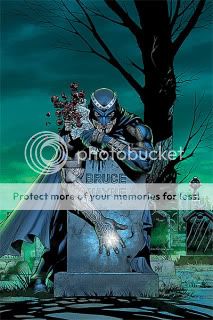
Green Lantern #43-51
Geoff Johns, writer
Doug Mahnke, artist
Ed Benes, artist on issue #47
DC, 2009-2010
22 story pages each except #50 which was longer
$2.99 each
Off the top of my head, here’s the stuff you’ll find in these Blackest Night tie-in issues of the ongoing Green Lantern series: Black Hand, Black Hand becomes the embodiment of the Black Lantern Corps, Martian Manhunter, Abin Sur, Abin Sur’s sister and Sinestro’s girlfriend Arin Sur, Barry Allen, John Stewart and that planet he blew up, John Stewart was part of Black Hawk Down, the Star Sapphires vs. the Sinestro Corps, Sinestro vs. Mongul for control of the Yellow Lanterns, the new Rainbow Lantern team featuring the Flash and Wonder Woman and Lex Luthor and so on, the Spectre, Parallax, Hal Jordan deliberately becoming Parallax again, Parallax getting kidnapped by some force only Hector Hammond is aware of, the Predator escapes from Zamaron, Blue Lanterns vs. Orange Lanterns, Red Lanterns vs. Green Lanterns, all the leaders of the different Corps teaming up, Orange Lantern Lex Luthor figures out that the Black Lantern Corps works the same way that the Orange Lantern “Corps” does, Ganthet becomes a Green Lantern, it looks like the Spectre might be to the Red Lanterns what Parallax is to Yellow and Ion is to Green and Predator is to Violet and Black Hand is to Black but he’s not but there’s a Red entity out there someplace…It’s crazy. The Yellow Lantern Scarecrow gets crucified at one point–in Siege, the weight of that one beat would anchor an entire issue, but in this storyline it’s like half a page.
What you have here, in other words, is supercompressed storytelling as filtered through the sensibilities of someone who really isn’t interested in formal play (unlike Grant Morrison and…uh, um, those other writers who do supercompressed superhero comics besides Grant Morrison, you know the ones) so much as just taking every aspect of the greater Green Lantern mythos and exploring every possible permutation of it in as rapid succession as possible. Having had no brief with Green Lantern before Geoff Johns started writing him, I’m surprised to find myself enjoying this stuff this much, and on this geeky a level. I mean, when I read today’s issue and realized that the Spectre might be the Red Entity, I actually gasped out loud. And I couldn’t care about the Spectre less! It’s just that kind of comic. If you enjoy the world Johns has built from the pieces of Green Lantern he found lying around and started connecting, watching the increasingly elaborate edifice he’s constructing here is a true treat.
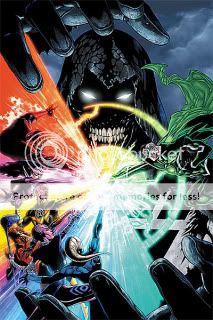 And when you sit and read it all at once, it’s not even incoherent–it’s just like a constant stream of rad shit hitting your eyeballs, and provided you have the kind of brain equipped to file away genre arcana and recall it as necessary, it flows from one thing into the next with the clarity and purpose of a freight train. Artist Doug Mahnke is an indispensable part of why this works. Mahnke rapidly ascended into my half-dozen or so favorite contemporary superhero artists over the course of his past three major projects; his segue from Final Crisis/Superman Beyond to these key Blackest Night tie-ins is arguably the first smooth transition from one project to another that any of DC’s event-comics artists have pulled off. (Seriously, Rags Morales, Phil Jimenez, J.G. Jones, and Carlos Pacheco all disappeared from DC after their star turns.) What makes him such a good fit here is both his proficiency with horror and monster-movie imagery (standout moments include Black Lantern Abin Sur using his ring to create a ravenous horde of giant floating disembodied black skulls, like he’s Stardust the Super-Wizard or something, and the way he paced Parallax’s fight with the Godzilla-sized Black Lantern Spectre to interrupt Orange Lantern Luthor’s tussle with Orange Lantern Larfleeze with the fall of one mighty foot) and the way his thick line, emboldened by inker Christian Alamy, holds the bright colors that the material demands. The funny thing is that the “dudes zapping dudes in all different directions” fight un-choreography I always complain about when I see it in ’90s X-Men books or contemporary Avengers titles is inherent to how these characters operate, but Mahnke’s visual imagination and ability to harness those effects and make them feel consequential rather than full of sound and fury but signifying nothing gets them over as involving battles anyway. This storyline–especially when read divorced from the larger plot points of Blackest Night with which it intertwines–is one of the great gonzo thrills provided by genre comics right now.
And when you sit and read it all at once, it’s not even incoherent–it’s just like a constant stream of rad shit hitting your eyeballs, and provided you have the kind of brain equipped to file away genre arcana and recall it as necessary, it flows from one thing into the next with the clarity and purpose of a freight train. Artist Doug Mahnke is an indispensable part of why this works. Mahnke rapidly ascended into my half-dozen or so favorite contemporary superhero artists over the course of his past three major projects; his segue from Final Crisis/Superman Beyond to these key Blackest Night tie-ins is arguably the first smooth transition from one project to another that any of DC’s event-comics artists have pulled off. (Seriously, Rags Morales, Phil Jimenez, J.G. Jones, and Carlos Pacheco all disappeared from DC after their star turns.) What makes him such a good fit here is both his proficiency with horror and monster-movie imagery (standout moments include Black Lantern Abin Sur using his ring to create a ravenous horde of giant floating disembodied black skulls, like he’s Stardust the Super-Wizard or something, and the way he paced Parallax’s fight with the Godzilla-sized Black Lantern Spectre to interrupt Orange Lantern Luthor’s tussle with Orange Lantern Larfleeze with the fall of one mighty foot) and the way his thick line, emboldened by inker Christian Alamy, holds the bright colors that the material demands. The funny thing is that the “dudes zapping dudes in all different directions” fight un-choreography I always complain about when I see it in ’90s X-Men books or contemporary Avengers titles is inherent to how these characters operate, but Mahnke’s visual imagination and ability to harness those effects and make them feel consequential rather than full of sound and fury but signifying nothing gets them over as involving battles anyway. This storyline–especially when read divorced from the larger plot points of Blackest Night with which it intertwines–is one of the great gonzo thrills provided by genre comics right now.
Quick additonal morning-after Lost thought
February 17, 2010SPOILERS AHEAD
Something I JUST thought of as I was fixing my generic cheerios that I thought deserved a post rather than a comment: Ethan and Ben were both already on the Island when Jack and company successfully blew it up in the alternate timeline–Ben was a kid and he’d been shot by Sayid and handed over to Richard and the Others, and Ethan was a little baby who’d just been born to Horace and Amy Goodspeed. So how are they walking around leading happy lives as productive members of society there on Earth X? Shouldn’t they be at the bottom of the ocean, or long dead from radiation poisoning? Do the ripples of “the incident” go both forwards AND backwards through the timestream, so that things somehow changed and now they were never on the Island at all? Or is there more to their current alternate-reality incarnations than meets the eye? Or is the “alternate reality” something else entirely?
Lost thoughts
February 16, 2010SPOILERS AHEAD
* “Hello, Lost viewers! It was great to have you swing by last week. This week, we’ll be shifting gears and focusing on characters you like doing awesome things like turning into smoke monsters, grabbing machetes, scaring the shit out of Immortal Guy in Eyeliner, climbing down Indiana Jones rope ladders, explaining the origin of the Numbers, and listening to Iggy and the Stooges. Meanwhile, in an alternate reality, we’ll show them being well-adjusted, becoming besties with their archnemeses, and marrying Katey Sagal.”
* In other words, ohhhhhhh maaaaaaannnnnnn that was outstanding.
* Because we’re so used to how Lost works structurally and in terms of the roles of the characters, shifting those things around really makes an impact. Normally this takes the form of flipping the “flashback/forward/sideways” switch. But they can do it with how the characters are behaving as opposed to how they used to behave, too. And in this episode they did that twice: First by taking Richard, whose primary superpower has been inflappability, and showing him absolutely frantic and terrified. Instead of striding up calmly to whoever we’re following, this time he sneaks up wild-eyed and panicked, and runs away mid-sentence like Tony Soprano seeing the Feds approaching across the snowy backyard. Second they do it by showing Ben actually admit that Locke shits bigger than him, going so far as to finally end his ruse about Locke’s death. Not about Jacob’s death, of course–let’s not get crazy here. But still. You do those two simple things and all of a sudden it’s like wow, new ballgame. The show even made reference to something similar diegetically, with Sawyer picking up on Fake Locke because Real Locke always had a tinge of false bravado to him. Say what you will about Real Locke, but that bravado ain’t false.
* Locke’s flashsideways was deeply, deeply satisfying, wasn’t it? The second I saw him in a big suburban house instead of a crappy apartment, I figured Katey Sagal would be returning, and that was wonderful to see, especially when it became apparent that they had a healthy relationship. But what really made it click for me was when he fell off the ramp and onto the front yard: Instead of throwing his usual rage-filled tantrum about his lot in life, he just grinned as the sprinkler kicked in, in a good-natured “man, ain’t that a kick in the head?” kinda way. Turns out he was still struggling with the same compulsion to prove himself capable of things he’s incapable of that we’ve always seen from him, but the struggle was less severe and damaging to him, and he was ultimately able to walk away and move on.
* The kicker to the sequence, of course, was when he meets Benjamin Linus, European History teacher, at which point I was literally holding my arms aloft in triumph and cheering. Terry O’Quinn’s magnificent smile at the very end–the look of a man who knows he’s just met someone who’ll be a great friend, which really does happen from time to time–is one of my all-time favorite Lost moments, full stop. This is what I’m talking about, man.
* The Island storyline was rad, too. I want to focus on the cave scene because I think it’s the first time we’ve ever seen little recap-style flashbacks presented to us while characters continue to speak in the flow of the narrative. Am I right? This technique is straight outta Murder She Wrote, or Wadsworth telling us how it was all done during the various endings of Clue. In other words? ANSWERS!
* I couldn’t help but think, even after they showed that the Numbers originated with Jacob’s list of people, of how Cuse and Lindelof have said that viewers will continue to demand that they drill down deeper into them, like a kid repeatedly asking “Why?” until you’re saying stuff like “Because God said ‘because'” or whatever.
* Why only one Kwon? Why no Austen? Were these just the 42 front-section passengers of Oceanic 815, or are they 42 people drawn from all sorts of groups–the Tailies, the Others, Not Penny’s Boat, Ajira, Widmore’s Army unit, Desmond, Dharma, etc.?
* Jumping back for a sec, if Locke’s on good terms with his dad, what happened to his spine?
* Fake Locke/Man in Black is obviously an unreliable narrator, but I didn’t get a whole lot of cues that he was not to be believed in this case. Maybe Jacob will turn out to be a straight-up White Hat, but the “rival puppetmasters with pawns in the middle” theory of Lost seems a lot more thematically resonant with what’s actually happened on the show.
* Sawyer joining forces with the MIB is like Wolverine going to work for Magneto.
* I’m totally buying it, by the way. Great new positioning for that character, and perfect for his inevitable heroic self-sacrifice.
* Who is the mysterious kid? I think everyone probably thought “Young Jacob” at first, especially when it seemed like Richard couldn’t see him and he just disappeared. But Richard wasn’t facing that direction, and he could have scooted away while Fake Locke was looking at Richard instead for that brief moment. Sawyer could see him, after all, though who knows what that means at this point. I started wondering if he’s some Walt-style superpowered real-live kid currently hanging out at the Temple or something. Was he that kid they kidnapped from the Tail Section, does anyone know?
* I’m also thinking that this is where Walt’s importance will lie. I’m more confident than ever that we’ll get a satisfying answer for both him and the importance of childbirth and the lack thereof on the Island.
* Lapidus is priceless. Special to Kiel: Screw Hurley, that’s your mom’s audience-identification character.
Carnival of souls
February 16, 2010* Chris Mautner takes a look at Al Columbia’s Pim & Francie, the best comic of 2009.
* Hey, the comics section of the McSweeney’s newspaper experiment The San Francisco Panorama is now sold separately. Sold! Smart move, Eggers.
* My friend and CBR overlord Kiel Phegley reviews James Robinson’s Starman Blackest Night special and Superman: Mon-El at length. This is the kind of close reading of how superhero comics work or don’t work that I usually save for chats with friends over lunch or email, and Kiel is one of those friends, so getting a rare chance to see him work his review chops in public is a pleasure. If you’re at all interested in this kind of comics, I think he’s worth reading here even where (I think) I disagree with him.
* Comics, you can keep bleeding sales off the top of the monthly charts as long as you also keep opening up whole new wings of yourself for us to discover, like this King Aroo thing for example.
* How John Porcellino learned to stop worrying and love the Smiths. For me it was a combination of discovering that Morrisey’s Your Arsenal was produced and sounded a lot like Mick Ronson and enjoying Morrisey’s modern-day transformation into a beefy British gangster, and simply tracing these things back to their point of origin. Still not sure I get the Johnny Marr hysteria, but whatevs, I guess there are Moz men and Marr men same as John and Paul or Stan and Jack or Mick and Keef or whoever else.
* Goddammit, Mike Baehr’s Yoda sketchbook is slaughtering my Bowie book. I know the guy works for a comic company and can threaten to shittalk artists to Gary if they fail to produce, but still. 170 entries! Goddammit! Here’s Anders Nilsen’s. Razzafrazza. (Via Flog.)
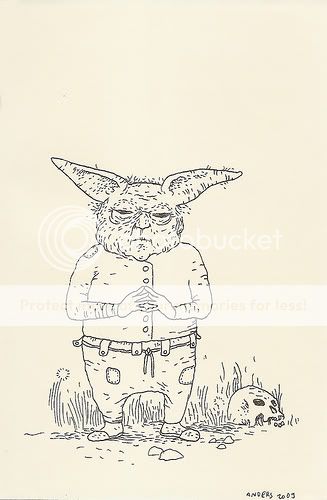
* Is there anything finer than a drawing of Batman’s awesome rogues gallery by a talented artist like David Petersen? That Muppet piece is pretty sweet too. Click the link to see them both at full size.
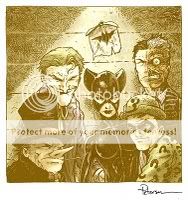
* DC Direct is releasing a cool line of 75th anniversary figures, featuring all their big characters as they looked in their debuts. I’d love to see that Shuster Superman slug a Doomsday action figure in the face.

* CRwM dissects the extremely unpleasant-sounding Korean torture-porn film The Butcher. I’ve been thinking of this subgenre, or at the very least what I used to call the “brutal-horror” ubersubgenre to which it belongs, on and off ever since I tried and failed to watch the French film Inside. If you recall, I gave up when it became apparent they were gonna break a cat’s neck, because that’s very very much not my thing, and I didn’t feel like the movie was going to be saying something in so doing that was particularly worth hearing. (No, “That bitch crazy!!!” doesn’t count.) But I don’t think I’ve seen a single horror film with a similar level of violence ever since, cat-killing or no. No Martyrs, no Frontier(s), no Asian or French extreme films, nothin’. And this is because I’m just not convinced I’d enjoy them, which is supposed to be the goal of going to the movies, right? I know that’s a weird thing to hear coming from someone who loves Hostel and The Texas Chain Saw Massacre as much as I do, but there you have it. Does this make me a wuss or a lousy horror fan? I really don’t know. I worry that it might, as I think I’ve said before. I wish I could articulate why the really awful movies that work with me work and the really awful movies that don’t work with me don’t, but to do that I’d have to see the latter ones, and, well, there you go.
Comics Time: GoGo Monster
February 15, 2010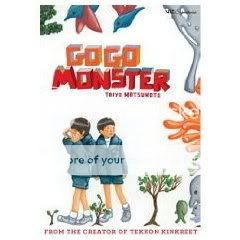
GoGo Monster
Taiyo Matsumoto, writer/artist
Viz, December 2009
464 pages, hardcover/slipcase
$27.99
It may only be the fact that Brian Chippendale just wrote about Taiyo Matsumoto yesterday, but I’d say GoGo Monster is every bit the exercise in creating a believable, cohesive, living environment that is Ninja or Multiforce or The Squirrel Machine. In fact I’d say that despite appearances to the contrary, this is truer of GoGo Monster than of Matsumoto’s Tekkon Kinkreet. TK‘s Treasure Town gives Matsumoto a far more obvious world-building workout, but ultimately its semi-dystopian near-future science-fiction metropolis can coast on our foreknowledge of such fictional environments and the narrative function they fulfill. GoGo Monster‘s run-of-the-mill elementary school can tap into our actual real-world memories of such places, certainly, but its place in a fictional narrative is comparatively undefined. Nor can it rely on the riot-of-detail school of art to accrue physical presence through a prolificacy of constituent visual parts as can those books–it’s not some fantastical land, it’s a grade school, and moreover that’s not the style Matsumoto is employing here. So to convey the kind of place Asahi Elementary School is–or at least the kind of place it is for our main characters–Matsumoto works overtime.
And he starts right away: Before we even get past the endpapers, deep-focus drawings reveal cavernous institutional hallways and vertiginous stairways, while POV close-ups of other characters reveal preoccupied teachers (that recurring pull-back-the-hair gesture!) and hostile, slightly distorted children, their speech not tied to them in the traditional word-balloon fashion, so as to suggest their fundamental disconnect from our hero. They’re not actors so much as elements, and their primary influence throughout the rest of the book is as a generator of sound effects just like wind or rain, as their near-constant disembodied chatter unfeelingly surrounds and buffets the protagonists.
Our real introduction to the school setting comes in the form of a hand-drawn map created by our main character, Yuki. It’s diagrammed out like a superhero’s headquarters, with all the funneling of wild imagination into cold orderly lines that that suggests. At the edges, menace creeps in, in the form of monstrous doodles that blackly snap at the border and proliferate in the school’s abandoned fourth floor. That level of the building takes on a central metaphorical role, demonstrating that this school exists independent from and indifferent to the hopes and fears of the child now inhabiting it.
Similar signifiers abound. Planes fly low overhead, their departure and destination unknown. A rabbit run is the only world its furry inhabitants ever know, and one of them disappears without any of its fellows or minders able to say how or to where. I have no idea if “perspective” has the dual meaning in Japanese that it does in English, but Matsumoto frequently skews and warps it so that the school leans in on its inhabitants. One pivotal character literally sees the world from inside a cardboard box. Most importantly, except for one key sequence I won’t spoil here, our heroes never leave the school grounds, and on the one occasion that parents visit, they are viewed only from a distance.
In short (haha, yeah), Asahi Elementary is the world for Yuki, who is either psychically sensitive or psychologically impaired, and Makoto, the new kid at school who befriends Yuki out of what seems more like a fascinated respect for his indifference to his peers than any kind of Heavenly Creatures-style shared psychosis, and for IQ, the eccentric-genius older kid who says he’s no more capable of taking a test without wearing his customary cardboard box than a normal person would be if forced to wear one. Their problems are solely their own and completely inescapable. If they don’t solve them, they won’t be solved.
Which makes GoGo Monster a harrowing read, in spite of the great beauty of the art. Indeed, the beauty makes the book feel like a tragedy in the making at every step. Whether they’re the product of a genuine gift or profound mental illness, Yuki’s increasingly troubling visions of a world beyond this one and the sinister Others who inhabit it can only bode poorly for him; either way, they will consume him, because in this insular world, there is no authority to which he has recourse to protect him. Yet at the same time he clings to these visions precisely because of the insularity of this world, and what it has shown him about the gray soullessness of grown-ups and their inability to connect with kids like him in any meaningful way. Only Ganz the groundskeeper and gardener understand Yuki’s plight from the adult world, but that understanding comes hand in hand with the conviction that it is in fact Yuki’s plight; Ganz tends him like a flower, but (hey, the metaphor is Matsumoto’s not mine) Yuki must blossom or wilt on his own.
In turn, Makoto and IQ are stand-ins for our own reaction to Yuki. Makoto is agnostic as to the veracity of Yuki’s visions; all he knows is that he’d prefer Yuki not have them, or at least not talk about them, because they’re frightening and they obscure the confident, funny, fascinating Yuki he otherwise knows. IQ is an atheist about them–he knows they’re all in Yuki’s head, the manifestation of various psychological complexes. But he offers this diagnosis while wearing a cardboard box on his head with an eyehole cut out, and eventually we learn this is the least of his own problems. Knowing what’s real is no help when what’s real appears to come crashing down.
In the book’s climax, that’s precisely what happens. We’re really no closer to understanding what’s really happening, though the nods in the direction of magic realism are as pronounced as, say, the end of Being There or Barton Fink. And we can only partially puzzle out the fate of a third of our trio, though sitting here after the fact I have my strong suspicion. No, Matsumoto is content to plunge characters and reader alike into a prolonged sequence of abstracted imagery, page after page that eventually becomes almost entirely obscured by darkness (which is itself depicted in just about the most fascinating way I’ve ever seen a comic do). What, if anything, emerges from the other side? Again, I’m not spoiling it here. But the journey through is a fine, emotionally accurate, uncompromising vision of the terrors of childhood. See, whether we are experiencing mental illness or actual spiritual evil here is a matter of debate–it works either way–but it definitely works as the realization that whatever meaning, safety, sanity, and comfort you can carve out of the unfeeling world, you have to carve it out yourself.
